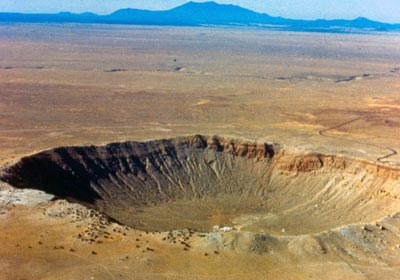SUDDEN IMPACT
About 50,000 years ago, a blinding flash of light in the sky preceded an explosion on earth equivalent to 20 million tons of TNT. A meteor of nickel-iron speeding along at around 40,000 miles an hour had smashed onto a plain east of where Flagstaff is today. The chunk of extraterrestrial rock, roughly 150 feet across and weighing several hundred thousand pounds, struck the earth with such force that fragments were buried 3,000 feet underground. About 80 percent of the meteor vaporized upon impact, then precipitated back to earth. Shock waves killed every living thing in the area. Perhaps five percent of the meteor had worn away by the atmosphere on entry and another five percent was blasted out to rain down as fragments. An estimated 10 percent lies buried underground.
When the crater was first discovered in 1871, scientists thought it to be of volcanic origin. Philadelphia mining engineer Daniel Barringer, convinced that it was an impact crater, devoted the last 26 years of his life to finding the buried meteor. When drill holes in the crater floor missed the nickel-iron, he took a closer look at the rock layers and realized that the meteor had struck at an angle. He then started drilling on the southeast rim, where cores showed meteorite fragments, but a hard material jammed the drill bit at a depth of 1,376 feet as Barringer's money ran out. Despite the failure to recover a rich mass of metal, his geologic studies added to the world's knowledge of impact structures. By 1929, the year of Barringer's death, the scientific community had finally come around to believing the crater to be of meteoric origin, the first one on earth to be proved as such. Apollo astronauts learned about crater geology here, and they practiced travel on the lunarlike surface.
Though larger impact craters exist on our planet, none are so well preserved or spectacular. The giant pit measures 560 feet deep, 4,100 feet across, and 2.4 miles in circumference—enough room for 20 football fields.
Photo ©Meteor Crater Enterprises
